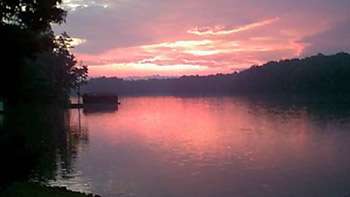
The trolling motor hums quietly against the chattering of insects and frogs. A darkening figure at the bow slowly guides his craft through the backwater maze of creek channel and weeds. He lets up softly from the pedal and silently glides the boat toward the empty blackness around the dock.
As the last remnants of daylight drain from the sky, David “Smitty” Smith continues his hunt for the wily nocturnal hawg.
A resident of Spotsylvania, teacher and owner of Smitty’s Tacklebox (smittystubes.com), a go-to site for several quality custom-made baits, David’s been fishing the waters of Lake Anna near Mineral, Va., for many years. In that time he’s earned the respect of his bass fishing comrades who also frequently choose to fish the darkening hours.
Smith expertly flips the Texas rigged creature bait under the dock and behind the piling. He brings the bait back in a series of quick hops and drops. A 2-pounder inhales the lure, and Smitty crosses its eyes with a powerful hookset.
“The shadows of docks and cover are great places to find bass, even at night” David says removing the hook from the bass’ mouth.
“Also, when they’re up shallow,” he continues, “don’t neglect the edges and holes of weedbeds. Bass’ll hole up in there waiting for food to pass by.”
Smith fishes a three-hour tournament out of High Point marina just about every Friday evening. The reason, he says, is simple.
“In the evening and at night, there are fewer people on the water compared to fishing the daylight. You just don’t have the number of pleasure boaters to contend with, and the temperature generally gets cooler, too.”
Smitty explains that his most productive time, as far as numbers of fish, is the last two hours of daylight. “During that time,” he says, “I catch a lot of fish but a lot of them are short, maybe 12 inches or so. Once the sun sets, I find that the number of bites drops off significantly, but the quality can be a lot greater.”
Night has fully dropped as we leave a cove full of lily pads with another keeper in the livewell. Just like the first fish, it was pulled from his watery hole by flipping a dark creature bait.
On the way to a bank littered with stumps, woody cover and rock, David explains that most of the time he catches good bass flipping plastics once the sun sets.
“But, once it really gets dark,” he grins, “my favorite baits are topwaters. You can do well with dark plastic like worms, craws or creature baits but, like most people, I love the sound of a bass hitting a topwater.”
“Also,” Smith adds, casting a popper toward the dark bank, “I find that the topwater bite after dark can bring in some quality fish. The trick is to look for small schools of baitfish dimpling the surface. Larger bass are usually following that school, and they home in on the popper — big bass like an easy meal.”
The short, three-hour tournament over too soon, we troll around the dock looking for a place to tie up. David takes this time to say hello to old friends and offer a few tips to the evening fisherman.
“First,” he explains, “don’t be afraid to use the same baits that work for you in the daytime. If you’re having luck with a specific bait, like a junebug or green pumpkin creature bait, then keep using it. Just keep a few of those baits and a couple of weights in your pocket so you can re-tie quickly without having to search too much in the dark.”
“Second”, he continues, “be able to tie knots in the dark. If you can tie a Palomar knot with your eyes closed, you won’t have a problem fishing at night. Also, make sure the brakes on your reel are just a little tighter than normal to prevent backlashes. Casting to specific targets at night becomes more of a challenge. Once you backlash badly, that reel is pretty much useless for the rest of the tournament or evening.”
As we find an open spot at a pier, Smitty reveals his concern with safety at night.
“Have your gear,” he notes, “especially emergency supplies, organized and stored in a place you can readily access. If you’re fishing with a partner, make sure they can get to it, as well. And, having a good flashlight is a must!”
“Lastly,” David offers, “make sure that someone knows where you’ll be fishing just in case there is a problem with the motor. That way, if you don’t arrive at a pre-arranged time, people will know where to find you. After all, cell phones don’t always work in all areas.”
The boat secured, we fill the weigh-in bag with a couple of pups and a nice hawg — enough for a respectable finish in a crowd of over 50 boats. Not bad considering the distraction of being interviewed the entire tournament!




